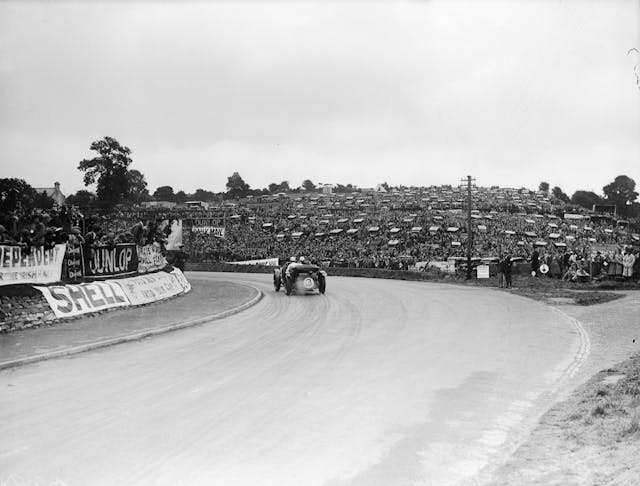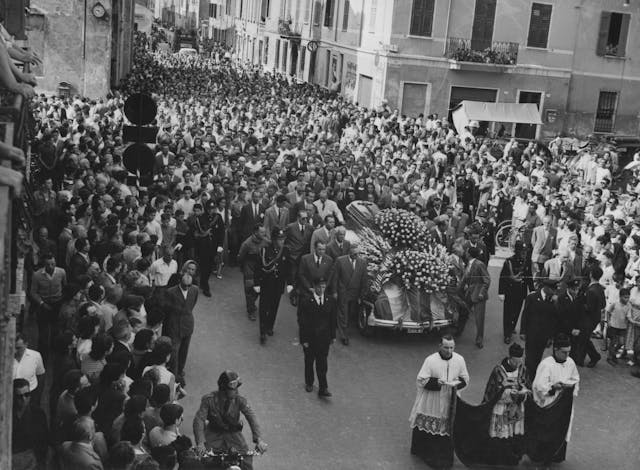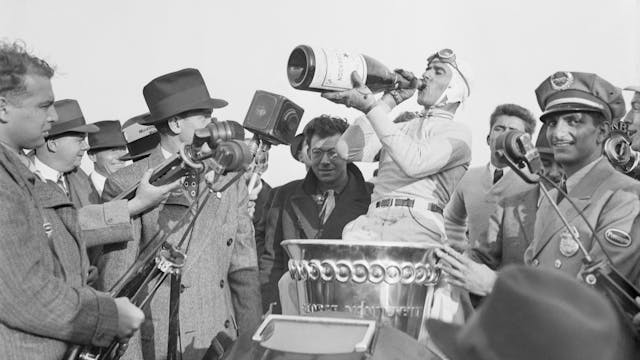Legends of Motorsport: Tazio Nuvolari
The life and times of Tazio Nuvolari—nicknamed the Flying Mantuan to honor his speediness and his hometown of Mantua, Italy—are littered with shattered car parts, empty champagne bottles, and insightful anecdotes. The most telling story is from Enzo Ferrari’s autobiography Le Mie Gioie Terribili (My Terrible Joys):
One day in 1931, during practice for the Circuito delle Tre Province, I asked [Nuvolari] to take me along with him for a while on the 1750 Alfa that my Scuderia had allotted him. It was the first time Nuvolari had competed in the race, and he was a little diffident because he had seen me at the wheel of a new Alfa 2.3-liter eight-cylinder that was more powerful than his own car. Anyway, he made no objection to my request and told me to get in.
At the first corner, I was certain that Tazio had taken it badly and that we were going to end up in the ditch; I braced myself for the shock. Instead, we found ourselves at the beginning of the straight with the car pointing down it. I looked at Nuvolari: his rugged face betrayed not the slightest emotion, not the slightest sign of relief at having avoided a 180-degree skid. At the second bend and again at the third, the same thing happened. At the fourth or fifth, I began to understand how he managed it, for from the corner of my eye I noticed he never took his foot off the accelerator, but kept it pressed flat to the floorboards. Bend by bend, I discovered his secret. Nuvolari went into the bend rather sooner than would have been suggested by me by my own driving instinct. But he went into it in an unusual way, this is to say, suddenly pointing the nose of the car at the inner margin just where the bend started. With the throttle wide open—and having changed down into the right gear before that frightful charge—he put the car in a controlled four-wheel skid, utilizing the centrifugal force and keeping the machine on the road by the driving force of its rear wheels. Right round the whole of the bend, the car’s nose shaved the inner margin, and when the bend came to an end, the machine was pointing down the straight without any need to correct its trajectory.
Despite my more powerful engine, Nuvolari won our race. I came in second, 32.9 seconds after him. Tazio said to me afterward, ‘I’ve never worked so hard in my life!’

Ferrari’s testimony affirms that Nuvolari invented the four-wheel drift. The year after their epic lapping, Ferrari retired from driving with 11 Grand Prix wins to his credit to concentrate on a grander calling: managing Italy’s most successful racing team.
Nuvolari, also nicknamed Nivola, was born on November 16, 1892, near Mantua in north-central Italy to affluent parents. His uncle Giuseppe was a champion cyclist and his first mentor. As with most successful racers in the early 20th century, Nuvolari began his career on motorcycles. In spite of two World War interruptions, he earned 15 motorcycle and 55 car victories over the span of three decades.

Nuvolari received his motorcycle-racing license in 1915 but didn’t begin competing until 1920 at the Circuito Internazionale Motoristico in Cremona where he failed to finish. The following year he started racing cars, scoring a victory in the Coppa Verona reliability trial. By the mid-1920s, he had won championships in 350cc and 500cc motorcycle classes and victories in 1.5- and 2.0-liter sports cars.
That success caught Alfa Romeo’s eye. Seeking a replacement for Antonio Ascari who perished on July 26, 1925, Alfa gave Nuvolari a test drive at Monza. Unfortunately, transmission failure resulted in a major crash. The up-and-coming driver sustained a serious back injury and wasn’t picked for the team, though that didn’t slow Nuvolari down. Two weeks later, he had his doctor wrap his torso so he could mount a motorcycle. His mechanics hoisted him aboard his Bianchi 350 with a pillow cushioning his chest. Following a push-start, Nuvolari won the Nations Grand Prix at Monza in the rain.
This was hardly the last time Nuvolari raced impaired. After breaking two ribs racing his motorcycle in the summer of 1929, he finished second in the Coppa Ciano driving an Alfa with his chest secured within a plaster corset. In 1934, he finished fifth at Germany’s AVUS Rennen with his right leg in a cast and his Maserati 8CM rigged so he could operate all three control pedals with his left foot. In 1936, after being thrown from his Alfa and sustaining cracked vertebrae, Nuvolari scored an eighth-place finish at Tripoli. In 1938, he struck a deer practicing for the Donington GP and broke a rib; the next day he won the race in his Auto Union D-Type. Nuvolari’s Alfas caught fire at speed in 1937 and ’38.

While leading the Coppa Brezzi in 1946, the steering wheel of Nuvolari’s Cisitalia D46 came off in his hands. Frantically waving the errant wheel to alert his mechanics, Nuvolari completed the lap before pitting by grasping the steering shaft with his free hand. After repairs he returned to the race to finish 13th. When he resumed racing after World War II, Nuvolari steered with one hand, the other holding a bloody handkerchief over his mouth. His lungs had been damaged by the toxic fumes he had breathed while closely trailing the prewar German Silver Arrow racers. At some point in his career, Nuvolari lost an index finger and one leg was more than an inch shorter than the other. However, even his sacrifices pale in comparison with the fates of fellow drivers who gave their lives for the sport.
Proving his tactical skills, Nuvolari switched his headlamps off to sneak up behind his teammate Achille Varzi, who was leading the 1930 Mille Miglia in his Alfa 6C 1750. A few miles before the end, he switched his lights on and flew past Varzi to victory. Another ploy was dispatching his riding mechanic under the dashboard to lower his racer’s center of gravity. One such helper reported spending an entire race as Nuvolari’s hidden ballast.

Nuvolari drove Bugatti Type 35s he owned from 1927 through 1929 to five major victories. He piloted Alfas from 1930 through 1937. In 1931, Nuvolari finally parked his motorcycles to focus on four-wheeled racers. The following year, Italy’s beloved poet Gabriele D’Annunzio invited him to his estate to present a golden turtle badge inscribed with “To the fastest man in the world, the slowest animal.” That keepsake became Nuvolari’s good-luck charm, which he carried in his pocket at all times. He also embroidered the turtle image on his racing jerseys and personal stationery along with stylized initials. The bright-yellow jerseys and blue slacks Nuvolari wore made him the most eye-catching driver on the grid.
The Alfa Romeo factory relinquished all of its racing efforts to Scuderia Ferrari in 1933. After Nuvolari’s victory at Le Mans that year, disagreement with Enzo prompted his move to Maserati 8CMs. Nuvolari’s victories continued at the Belgian and Nice Grand Prix events and the Coppa Ciano.
Thanks to intervention by Il Duce—Italy’s prime minister, Benito Mussolini—Ferrari and Nuvolari reconciled before the beginning of the 1935 racing season. Their renewed collaboration yielded eight victories in Alfas that year, followed by seven more in ’36 and ’37.
Nuvolari’s most memorable win came during the 1935 German Grand Prix at the Nürburgring. Driving an outdated Alfa P3, he faced five Mercedes-Benz W25s and four Auto Union Type Bs, all factory backed. On the rain-slick, 14.2-mile, 174-turn Eifel mountain track, Nuvolari mercilessly hounded the Mercedes-driving leader, Manfred von Brauchitsch, until the German wore out his tires. In spite of one long pit stop caused by a broken refueling pump, Nuvolari won the four-hour race by more than two minutes. Officials of the Third Reich were mortified when 300,000 spectators cheered his success.
By 1938, Nuvolari was tired of racing uncompetitive Alfas against state-of-the art Silver Arrows. After Auto Union hired him to replace their fallen star Bernd Rosemeyer, Nivola returned the favor with two victories in 1938 plus a win at the 1939 Belgrade, Yugoslavia, Grand Prix—just two days after the Nazis invaded Poland.
Nuvolari competed in 33 more races and hill-climbs after the war in spite of his deteriorating health. His final stint at the wheel was the 1950 Palermo-Montepellegrino hill-climb, where he won his class in an Abarth-tuned Cisitalia Spyder.
Following two paralyzing strokes, the great Italian maestro died in bed at home in 1953. Thousands of friends and fans attended his funeral. Ferdinand Porsche offered the most succinct eulogy, calling Nuvolari “the greatest pilot of the past, the present, and the future.”



